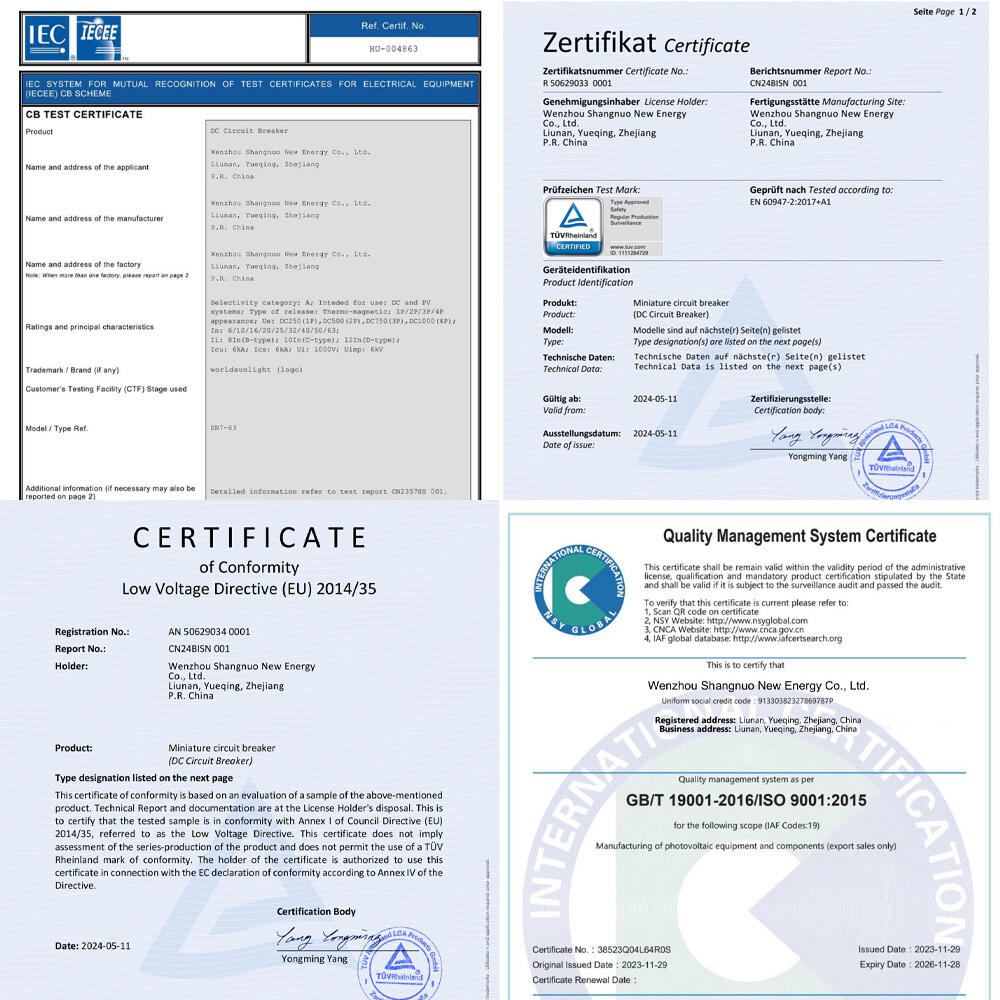In the rapidly evolving solar energy landscape, photovoltaic combiner boxes serve as critical components that ensure the safe and efficient operation of solar power systems. These essential electrical enclosures consolidate multiple DC inputs from solar panel strings into a single output, providing protection and monitoring capabilities that are vital for system reliability. Understanding the key features that define high-quality photovoltaic combiner boxes can help system designers, installers, and operators make informed decisions that maximize both performance and safety.

Essential Protection Features for Solar Array Safety
Overcurrent Protection Mechanisms
Reliable photovoltaic combiner boxes incorporate robust overcurrent protection systems that safeguard solar installations from electrical faults and equipment damage. These protection mechanisms typically include high-quality fuses or circuit breakers specifically rated for DC applications, which can interrupt fault currents safely and effectively. The overcurrent protection devices must be properly sized to handle the maximum expected current from each string while providing adequate protection margin. Modern combiner boxes often feature individual string monitoring capabilities that allow operators to identify problematic strings quickly, reducing system downtime and maintenance costs.
The selection of appropriate overcurrent protection devices requires careful consideration of the solar panel specifications, environmental conditions, and applicable safety standards. Quality combiner boxes utilize fuses or breakers that meet or exceed industry standards such as UL 2579 and IEC 60269, ensuring reliable operation under various operating conditions. Additionally, these protection systems must be designed to handle the unique characteristics of DC fault currents, which can be more challenging to interrupt than AC currents due to the absence of natural current zero crossings.
Surge Protection and Grounding Systems
Effective surge protection represents another fundamental feature of reliable combiner boxes, protecting valuable solar equipment from lightning strikes and other transient voltage events. High-quality surge protection devices (SPDs) are strategically positioned within the combiner box to divert excessive voltages safely to ground, preventing damage to inverters, monitoring equipment, and other downstream components. The surge protection system must be coordinated with the overall system grounding architecture to ensure optimal performance and compliance with electrical codes.
Proper grounding systems within photovoltaic combiner boxes serve dual purposes of safety and performance enhancement. The equipment grounding conductor provides a low-impedance path for fault currents, enabling protective devices to operate correctly and quickly. Additionally, the grounding system helps minimize electromagnetic interference and ensures that all metallic components remain at safe potential levels during normal operation and fault conditions.
Environmental Durability and Construction Standards
Weatherproof Enclosure Design
The enclosure design of photovoltaic combiner boxes must withstand harsh outdoor environments while maintaining reliable operation over decades of service life. Quality combiner boxes feature robust construction materials such as corrosion-resistant aluminum or fiberglass-reinforced polyester that can endure extreme temperatures, UV radiation, and moisture exposure. The enclosure ingress protection rating, typically IP65 or higher, ensures that dust and water cannot penetrate the interior and compromise electrical components or connections.
Thermal management represents a critical aspect of enclosure design, as combiner boxes generate heat during normal operation and must dissipate this heat effectively to maintain component reliability. Advanced designs incorporate features such as internal heat sinks, ventilation systems, or thermal barriers that help maintain optimal operating temperatures. The enclosure must also provide adequate space for proper wire routing and component accessibility while maintaining the required safety clearances specified by electrical codes.
Material Quality and Corrosion Resistance
Long-term reliability of photovoltaic combiner boxes depends heavily on the quality of materials used in their construction and the manufacturing processes employed. Premium combiner boxes utilize marine-grade hardware, stainless steel fasteners, and specialized gaskets that resist degradation from UV exposure, temperature cycling, and chemical exposure. The internal components, including busbars, terminal blocks, and wiring, must be constructed from materials that maintain their electrical and mechanical properties throughout the expected service life.
Corrosion resistance becomes particularly important in coastal environments where salt spray and high humidity can accelerate material degradation. Quality manufacturers employ advanced coating systems, sacrificial anodes, or inherently corrosion-resistant materials to ensure long-term performance in challenging environments. The selection of appropriate materials must consider not only the immediate operating environment but also potential changes in environmental conditions over the system's expected lifespan.
Electrical Performance and Connection Systems
High-Quality Terminal Connections
Reliable electrical connections form the backbone of effective combiner box operation, requiring high-quality terminal blocks and connection systems that maintain low resistance and mechanical integrity over time. Professional-grade combiner boxes feature terminals designed specifically for DC applications, with appropriate current ratings and contact materials that resist oxidation and thermal cycling effects. The terminal design must accommodate the wire sizes commonly used in solar installations while providing secure connections that resist loosening due to thermal expansion and contraction.
Connection accessibility represents another important consideration, as maintenance personnel must be able to safely inspect and service connections throughout the system's operational life. Well-designed combiner boxes provide clear labeling, adequate working space, and logical layout of components that facilitate both initial installation and ongoing maintenance activities. The use of color-coded terminals, clear documentation, and standardized connection methods helps reduce installation errors and simplifies troubleshooting procedures.
Current Rating and Voltage Capabilities
The electrical specifications of photovoltaic combiner boxes must align with the requirements of the specific solar installation, including maximum current capacity, voltage ratings, and short-circuit current handling capabilities. Quality combiner boxes are available in various configurations to accommodate different array sizes and system voltages, from residential installations to large utility-scale projects. The current rating must provide adequate margin above the expected maximum operating current to ensure reliable operation under all anticipated conditions.
Voltage ratings become increasingly important as solar system voltages continue to increase for improved efficiency and reduced installation costs. Modern combiner boxes must handle system voltages of 1000V or higher while maintaining appropriate safety clearances and insulation coordination. The design must also consider the potential for temporary overvoltages due to temperature effects, partial shading conditions, or system transients that could exceed normal operating levels.
Monitoring and Communication Features
String-Level Monitoring Capabilities
Advanced photovoltaic combiner boxes incorporate comprehensive monitoring systems that provide real-time visibility into individual string performance and overall system operation. These monitoring capabilities enable operators to identify underperforming strings, detect potential safety issues, and optimize maintenance scheduling. String-level current monitoring allows for precise fault detection and helps quantify the impact of shading, soiling, or component degradation on system performance.
The monitoring system must provide accurate measurements across the full range of operating conditions while maintaining long-term calibration stability. Quality monitoring solutions utilize precision current sensors, temperature compensation, and digital signal processing to ensure measurement accuracy. The data collection system should be capable of storing historical information and providing trend analysis capabilities that support both immediate operational decisions and long-term asset management strategies.
Remote Communication and Data Integration
Modern combiner boxes often include communication capabilities that enable remote monitoring and integration with broader energy management systems. These communication features may utilize various technologies such as cellular modems, ethernet connections, or wireless protocols depending on the specific installation requirements and available infrastructure. The communication system must be reliable and secure, protecting sensitive operational data while providing authorized users with convenient access to system information.
Data integration capabilities allow combiner box monitoring systems to work seamlessly with supervisory control and data acquisition (SCADA) systems, building management systems, or cloud-based monitoring platforms. This integration enables comprehensive system analysis, automated reporting, and coordinated control strategies that optimize overall plant performance. The communication protocols and data formats must be standardized and well-documented to ensure compatibility with existing and future monitoring infrastructure.
Installation and Maintenance Considerations
Mounting and Accessibility Features
Proper installation and ongoing maintenance access represent crucial factors in the long-term success of photovoltaic combiner boxes. Quality units feature versatile mounting options that accommodate various installation scenarios, from pole mounting to wall mounting or ground-level pedestals. The mounting system must provide secure attachment while allowing for thermal expansion and potential ground movement without compromising the enclosure integrity or electrical connections.
Accessibility features such as hinged doors, removable panels, and clear component labeling facilitate both initial installation and ongoing maintenance activities. The internal layout should provide adequate working space for technicians while maintaining required safety clearances and code compliance. Service-friendly designs include features such as test points, diagnostic indicators, and modular component arrangements that simplify troubleshooting and repair procedures.
Documentation and Compliance Standards
Comprehensive documentation and adherence to applicable standards ensure that photovoltaic combiner boxes meet safety requirements and perform reliably throughout their operational life. Quality manufacturers provide detailed installation manuals, wiring diagrams, and maintenance procedures that help ensure proper installation and operation. The documentation should include specific torque specifications, recommended maintenance intervals, and troubleshooting guides that support field personnel.
Compliance with relevant standards such as UL 2579, IEC 62109, and NEC requirements demonstrates the manufacturer's commitment to safety and quality. These standards address various aspects of combiner box design, including electrical safety, environmental performance, and electromagnetic compatibility. Regular third-party testing and certification provide additional assurance that the equipment will perform as expected in real-world applications.
FAQ
What is the typical lifespan of a high-quality photovoltaic combiner box
High-quality photovoltaic combiner boxes are designed to operate reliably for 20-25 years or more when properly installed and maintained. The actual lifespan depends on factors such as environmental conditions, installation quality, and maintenance practices. Components such as fuses, surge protection devices, and monitoring electronics may require replacement during this period, but the main enclosure and connection systems should provide decades of reliable service. Regular inspection and preventive maintenance help ensure optimal performance throughout the expected operational life.
How do I determine the correct size and configuration for my solar installation
Sizing a combiner box requires careful analysis of the solar array configuration, including the number of strings, maximum current per string, system voltage, and environmental conditions. The combiner box must have sufficient input capacity for all planned strings with appropriate current ratings for each circuit. Additionally, considerations such as future expansion plans, local electrical codes, and specific monitoring requirements influence the selection process. Professional consultation with qualified solar installers or electrical engineers is recommended to ensure proper sizing and configuration.
What maintenance is required for photovoltaic combiner boxes
Regular maintenance of photovoltaic combiner boxes includes visual inspection of the enclosure for damage or corrosion, verification of all electrical connections, testing of protection devices, and cleaning of the enclosure exterior. Internal components should be inspected annually or as recommended by the manufacturer, including checking for signs of overheating, corrosion, or component degradation. Monitoring system calibration, surge protection device status, and gasket integrity should also be verified periodically. Maintenance activities must be performed by qualified personnel following proper safety procedures.
Can combiner boxes be retrofitted with monitoring capabilities
Many existing photovoltaic combiner boxes can be retrofitted with monitoring capabilities, depending on the available space, electrical configuration, and compatibility with existing components. Retrofit monitoring solutions may include external current sensors, communication modules, and data logging equipment that can be added without major modifications to the existing installation. However, the feasibility and cost-effectiveness of retrofitting depend on the specific combiner box design and the desired monitoring features. Professional evaluation is recommended to determine the best approach for adding monitoring capabilities to existing installations.




